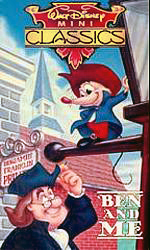| Ben and Me | |
|---|---|
 1989 VHS artwork | |
| Directed by | Hamilton Luske |
| Story by | Robert Lawson (novel) Bill Peet (screen story) Winston Hibler Del Connell Ted Sears (adaptation) |
| Produced by | Walt Disney |
| Starring | Sterling Holloway Charlie Ruggles Stan Freberg Hans Conried Bill Thompson Jimmy MacDonald |
| Narrated by | Sterling Holloway |
| Music by | Oliver Wallace |
| Animation by | Wolfgang Reitherman John Lounsbery Cliff Nordberg Marvin Woodward Hugh Fraser Eric Cleworth Ollie Johnston Hal King Les Clark Don Lusk Harvey Toombs Jerry Hathcook George Rowley (effects) |
| Layouts by | Al Zinnen Hugh Hennesy Thor Putnam |
| Backgrounds by | Al Dempster Thelma Witmer Dick Anthony |
Production company | |
| Distributed by | Buena Vista Film Distribution |
Release date |
|
Running time | 21 minutes |
| Country | United States |
| Language | English |
Ben and Me is an American animated two-reel short subject produced by Walt Disney Productions and released theatrically on November 10, 1953. [1] It was adapted from the book of the same name written by author/illustrator Robert Lawson and first published in 1939. Though both book and film deal with the relationship between a mouse and American Founding Father Benjamin Franklin, the book, with illustrations by Lawson, focused more heavily on actual historical events and personages, and included incidents from Franklin's French career at Versailles.
Contents
The short received an Academy Award nomination for Best Short Subject, Two-reel. [2]
This short was also notable for being the second release on the Buena Vista Distribution label, with the first being Toot, Whistle, Plunk and Boom , released on the same day. On its release, Ben and Me was packaged with the feature-length True-Life Adventures nature documentary film The Living Desert . When Disney's regular distributor RKO Radio Pictures resisted Disney's idea of releasing a feature-length True-Life Adventures nature documentary film, Disney formed his own distribution company to handle future Disney releases. [3]
A D-TV music video was created in which the short was set to Stevie Wonder's For Once in My Life .